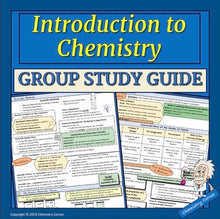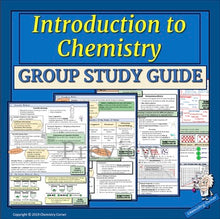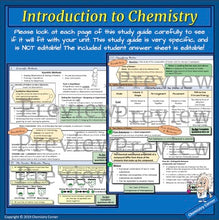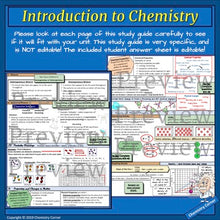**This resource is included as a free bonus in the Introduction to Chemistry MEGA Unit Bundle, and the Introduction to Chemistry Lessons Only Unit Bundle.
I have had such success using study groups when review time comes around. Students are assigned a study partner. Then when review time comes, I have them study with their study partner or with another pair of partners to form study groups. I think this is a great exercise in studying together, and hopefully they will continue to use this highly effective strategy when they are in college.
But the best thing about using study groups is that it frees up the teacher to monitor understanding, identify struggling students, or even pull a group to work with.
I have found that these colorful, illustrated study cards keep students engaged in the review. I laminate them on card stock so the color won’t bleed through, and I can make two-sided copies. Print a class set – enough for the number of groups you will have, and you will have this great resource for years to come.
The student answer sheet is mostly editable in case you want to change any of the questions to fit your needs.
SPECIAL NOTE: Please look through the preview for this resource above. Each page is shown clearly. This study guide is NOT editable, and it is very specific. Please make sure that it is suitable for your unit. The student answer sheet is editable.
Introduction to Chemistry Study Guide includes these objectives:
* Students will state the steps of the scientific method.
* Students will describe the differences between qualitative and quantitative observations.
* Students will compare and contrast hypothesis, scientific theory, and scientific law.
* Students will solve a problem/challenge as part of a group.
* Students will differentiate between three states of matter.
* Students will relate the states of matter to the Kinetic-Molecular Theory of Matter.
* Students will classify a sample of matter as a pure substance or a mixture.
* Students will distinguish between homogeneous mixtures and heterogeneous mixtures.
* Students will discuss different ways to separate mixtures and relate these to the physical properties of the components being used for separation.
* Students will label and produce particle drawings of the states and classes of matter.
* Differentiate between physical properties and chemical properties of matter
* Differentiate between properties of matter and changes of matter
* Differentiate between chemical changes and physical changes of matter
* Calculate density
* Graph density
Included in this resource:
* Group Study Cards (4 pages)
* Editable Student Answer Sheet
* KEY
This study guide will be a something you will want to use year after year!
This lesson is appropriate for grades 9-12 chemistry or physical science.
Chemistry Corner
*********************************************************************************
You may also be interested in these included products:
High School Chemistry Year Curriculum
Chemistry Doodle Notes for the Year: A Growing Bundle
Chemistry BellWork/WarmUps Editable- For the Entire Year
Chemistry Task Cards for the Year: A Growing Bundle
*********************************************************************************
Note: Chemistry Corner’s PowerPoints are perfect for the flipped classroom. However, please read the Copyright Terms below before using it as such. Thanks!
LICENSING TERMS: By downloading this product, you own a license for one teacher only for personal use in your classroom. Licenses are non-transferable, meaning they cannot be passed from one teacher to another. No part of this resource is to be shared with colleagues or used by an entire grade level, school, or district without purchasing the proper number of licenses. I you are a coach, principal or district interested in transferable licenses to accommodate yearly staff changes, please contact Chemistry Corner.
COPYRIGHT TERMS: ©Chemistry Corner. Please note – all material included in this resource belongs to Chemistry Corner. By downloading, you have a license to use the material, but you do not own the material. This resource, or any portion of this resource, may not be uploaded to the internet in any form, including classroom/personal websites or network drives, unless the site is password protected and can only be accessed by students—no other teachers or anyone else on the internet.








